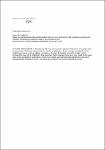Rapid and reliable detection of bacterial endospores in environmental samples by diagnostic electron microscopy combined with X-ray microanalysis
Laue, Michael
Fulda, Gerhard
Diagnostic negative staining electron microscopy is a front-line method for the rapid investigation of environmental and clinical samples in emergency situations caused by bioterrorism or outbreaks of an infectious disease. Spores of anthrax are one of the diagnostic targets in case of bioterrorism, because they have been used as a bio-weapon in the past and their production and transmission are rather simple. With negative staining electron microscopy bacterial spores can be identified based on their morphology at the single cell level. However, because of their particular density, no internal structures are visible which sometimes makes it difficult to distinguish spores from particles with a similar size and shape that are frequently present in environmental samples. Spores contain a high concentration of calcium ions besides other elements, which may allow a proper discrimination of spores from other suspicious particles. To investigate this hypothesis, negative staining electron microscopy, using either transmission or scanning electron microscopes, was combined with energy dispersive X-ray microanalysis, which reveals the element content of individual nanoparticles. A peak pattern consisting of calcium, sulphur and phosphorus was found as a typical signature within the X-ray spectrum of spores in various Clostridium and Bacillus species, including all strains of anthrax (Bacillus anthracis) tested. Moreover, spores could be reliably identified by this combined approach in environmental samples, like household products, soil or various presumed bioterrorist samples. In summary, the use of X-ray spectroscopy, either directly in the transmission electron microscope, or in a correlative approach by using scanning electron microscopy, improves the emergency diagnostics of suspicious environmental samples.
No license information

